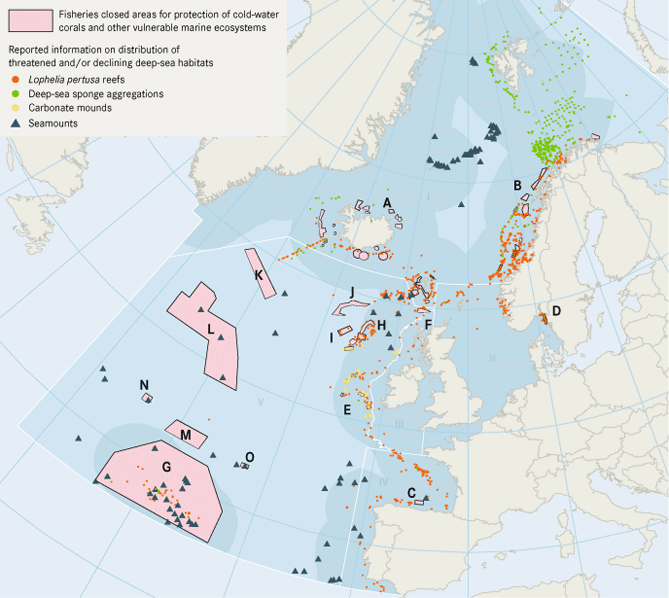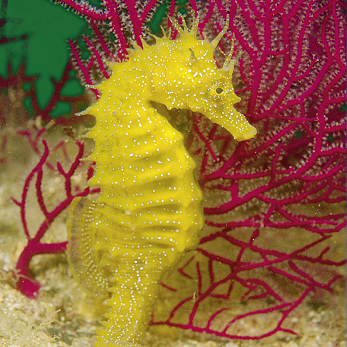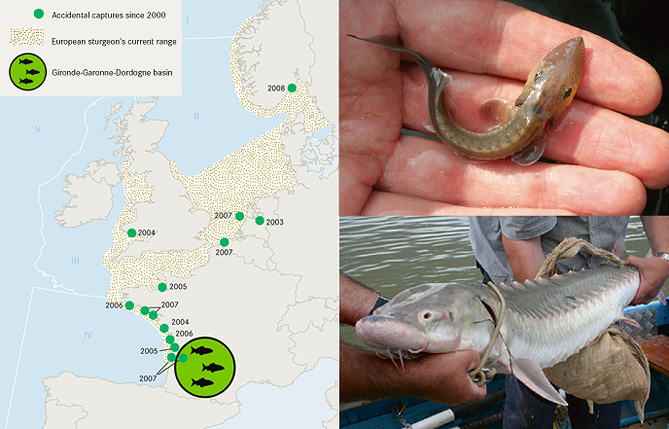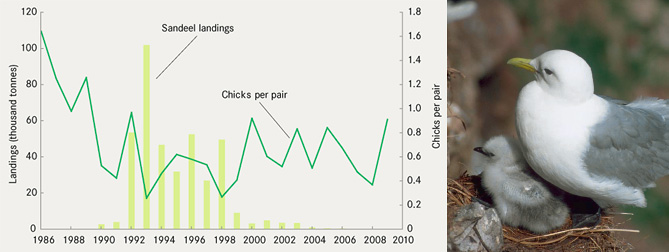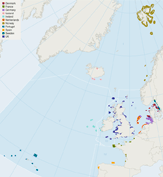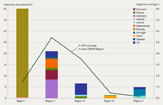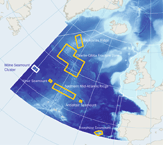Sea-pen and burrowing megafauna communities occur in soft muddy sediment and are very sensitive to seabed disturbance. They are found mainly in the shelf seas and deeper coastal waters of northern Region II and Region III, but also in parts of Regions I and IV. The high natural biodiversity of this habitat makes it very productive for fishing. The protection of this habitat in the North-East Atlantic has received little attention until now, with only limited protection provided through existing MPAs.
Other habitats for which priority actions are required include intertidal mudflats, Zostera beds, Modiolus modiolus beds, natural beds of oysters (Ostrea edulis), deep-sea sponge aggregations and seamounts.
OSPAR MPA network is developing from the Arctic to the Azores
By January 2010, the MPA network comprised 159 MPAs that together covered 147 324 km2 or 1.08% of the OSPAR area Table 10.4 and Figure 10.2.
Most MPAs are located within territorial waters, covering a substantial proportion of coastal waters (~13%), while 46 are located at least partly within Exclusive Economic Zones (EEZ) (covering 0.52%). Only one MPA is located on an extended continental shelf, which is claimed by Portugal. No MPA has yet been established entirely in areas beyond national jurisdiction.
The MPAs included in the OSPAR network offer protection for all invertebrates considered threatened and/or declining, three of the nine bird species listed, eight of the 22 fish species, both turtle species, three of the four mammal species, and all of the habitats listed. This is expected to improve as more MPAs are designated and management plans are developed and implemented Figure 10.3.
In Regions II and III, a substantial coverage of MPAs has been achieved in nearshore waters around the UK and Ireland and along the North Sea coast of Sweden, Denmark, Germany and the Netherlands. These protect a diverse range of coastal ecosystems, including tidal inlets and rivers, fjords, estuaries, salt marshes, sandbanks and rocky shores. Extensive areas of intertidal mudflats are included, with the Wadden Sea the most prominent example, together with seagrass beds (Zostera sp.), maerl, flat oyster beds, or intertidal mussel beds. The sites also host a number of species under threat and/or in decline, including harbour porpoise, common skate, salmon, cod, sea lamprey, dogwhelk, ocean quahog, and a variety of seabirds such as the Balearic shearwater or black-legged kittiwake. Some MPAs are dedicated to protecting cold-water coral reefs, for example in the Skagerrak. MPAs have also been established in offshore waters, specifically protecting reefs and sandbanks (e.g. the Dogger Bank in the central North Sea).
In Region IV, one MPA is located in offshore waters. The site (known as El Cachucho) protects a unique deep-sea ecosystem in the Cantabrian Sea. It is located in the Spanish EEZ and comprises an extensive elevated bank and seamount with a system of channels and canyons, and an inner basin that separates the bank from the continental shelf. Cold-water coral reefs, carbonate mounds, deep-sea sponges, giant squid and deep-water sharks are found at this site. The remaining MPAs in Region IV are situated along the Breton and Galician coastlines including the Mer d’Iroise to the west of Brittany (France). These sites include intertidal mudflats and beds of oysters, mussels and kelp, and rare species such as the leatherback turtle, loggerhead turtle and short-snouted seahorse.
In Region V, MPAs are being used to protect the cold-water reefs on the Darwin mounds off the north-west coast of the UK, a number of carbonate mounds in offshore waters to the west of Ireland and the rich marine ecosystems around the Azores. Three hydrothermal vent fields have been included in the MPA network: Menez Gwen, Lucky Strike and Rainbow Box 10.1, as part of the recently created Azorean Marine Park. The MPAs also include seamounts, volcanoes, deep-sea sponge aggregations and cold-water coral reefs, especially of Lophelia pertusa. Some of the species listed by OSPAR as threatened and/or declining only occur in Region V, for example, the Azorean barnacle, Azorean limpet and the little shearwater. Other threatened and/or declining species found in these MPAs include the blue whale, loggerhead turtle and orange roughy.
In Region I, MPAs have been established along the coast of Norway, around the Svalbard archipelago and in Icelandic coastal waters. Many protect cold-water coral reef systems, which provide important feeding grounds and shelter for several fish species, including commercially valuable species such as redfish, ling, and tusk. The most common macrofauna in these reef systems are deep-sea sponges, gorgonians, soft corals, squat lobsters, hermit and other crabs, and sea urchins. Around Iceland, two isolated hydrothermal vent fields are protected by MPAs. Three MPAs around Svalbard and Bear Island (Bjørnøya) form the most extensively protected zone in the OSPAR network, covering approximately 78 000 km2. These MPAs protect a highly biologically diverse and productive ecosystem that is considered to be one of the most important seabird areas in the world.
Ecological coherence of the OSPAR network
A comprehensive assessment of the ecological coherence of the current network of MPAs is hampered by the limited information available on the distribution of many species and habitats within the OSPAR area, including in OSPAR MPAs. A preliminary spatial assessment considering the distribution of OSPAR MPAs suggests that ecological coherence has not been reached across the entire OSPAR area. Within the North Sea, Celtic Seas and the Azores and around the Svalbard archipelago the current MPA coverage provides some degree of connectivity and representativity. It is clear that further sites need to be included in the network to ensure its coherence across the OSPAR area, especially offshore and in the deep seas.
Management status of MPAs
OSPAR is collecting and evaluating information on the management systems applied in the various MPAs. So far, most OSPAR MPAs are also Natura 2000 sites and so management regulations for these sites are based on the requirements of the Birds Directive and the Habitats Directive. However, an increasing number of the sites established as OSPAR MPAs are not Natura 2000 sites. For these a range of management plans, including conservation objectives and related measures, have been established following OSPAR guidelines. OSPAR has also established guidance for the involvement of stakeholders in the designation and management of MPAs, as has been done for the Swedish Koster-Väderöfjord MPA. Transnational cooperation is also taking place between Sweden and Norway in the development of the marine national parks Kosterhavet and Ytre Hvaler.
